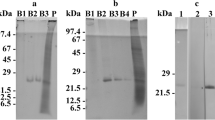Summary
Polyclonal antibodies directed against squid opsin were used in immunocytochemical and immunoblot experiments to identify a rhodopsin-like protein in photosensitive neurons of Aplysia. Aldehyde-fixed abdominal and cerebral ganglia were embedded in paraffin for peroxidase anti-peroxidase analysis or used whole for immunofluorescence studies. Ganglia were embedded in Lowicryl K4M for electron-microscope immunocytochemistry. In both the cerebral and abdominal ganglia, light-microscope immunocytochemical results showed reaction product deposited around the neuronal cell periphery corresponding in position to the lipochondria. In the abdominal ganglion, the giant cell R2, located in the right rostral quarter, and neurons in the right caudal quarter were consistently labeled with anti-opsin. Electron-microscopic studies demonstrated ferritin-labeling of the lipochondria in R2 and other immunoreactive neurons. Immunoblot analysis of R2 and cerebral neuron extracts was used to identify two prominent immunoreactive protein bands at 85000 and 67500 molecular weight.
Similar content being viewed by others
References
Andresen MC, Brown AM (1976) Voltage-clamp studies on the light response of identified interneuron L10. Biophys Soc Abstr
Arvanitaki A, Chalazonitis N (1961) Excitatory and inhibitory processes initiated by light and infra-red radiations in single identifiable nerve cells. In: Florey E (ed) Nervous inhibition. Pergamon, New York, pp 194–231
Baur PS, Brown AM, Rogers TD, Brower ME (1977) Lipochondria and the light response of Aplysia giant neurons. J Neurobiol 8:19–42
Benjamin PR, Walker TS (1972) Two pigments in the brain of a fresh-water pulmonate snail. Comp Biochem Physiol 418:813–821
Bok D, Dockstader J, Horwitz J (1982) Immunocytochemical localization of the lens main intrinsic polypeptide (MIP) in communicating junctions. J Cell Biol 92:213–220
Bok D, Ong DE, Chytil F (1984) Immunocytochemical localization of cellular retinol binding protein in the rat retina. Invest Ophthal Vis Sci 25:877–883
Brown HM, Brown AM (1972) Ionic basis of the photoresponse of Aplvsia giant neuron: K+ permeability increase. Science 178:755–756
Brown AM, Brown HM (1973) Light response of a giant Aplysia neurone. J Gen Physiol 62:239–254
Brown AM, Baur PS, Tuley FH (1975) Phototransduction in Aplysia neurons: Calcium release from pigmented granules is essential. Science 188:157–160
Brown AM, Brodwick MS, Eaton D (1977) Intracellular calcium and extra-retinal photoreception in Aplysia giant neurons. J Neurobiol 8:1–18
Coggeshall RE (1967) A light and electron microscope study of the abdominal ganglion of Aplysia californica. J Neurophysiol 30:1263–1287
Fitzgerald PG, Bok D, Horwitz J (1983) Immunocytochemical localization of the main intrinsic polypeptide (MIP) in ultrathin frozen sections of rat lens. J Cell Biol 97:1491–1499
Foster KW, Sarnak J, Patel N, Zarilli G, Okabe M, Kline T, Nakanishi K (1984) A rhodopsin is the functional photoreceptor for phototaxis in the unicellular eucaryote Chlamydomonas. Nature 311:756–759
Foster RG, Follett BK, Lythgoe JN (1985) Rhodopsin-like sensitivity of extra-retinal photoreceptors mediating the photoperiodic response in quail. Nature 313:50–52
Hara T, Hara R (1972) Cephalopod retinochrome. In: Dartnall HJA (ed) Handbook of sensory physiology. Vol vii/l. Springer, New York, pp 720–746
Hara T, Hara R (1980) Retinochrome and rhodopsin in the extraocular photoreceptor of the squid. J Gen Physiol 75:1–19
Henkart M (1975) Light-induced changes in the structure of pigmented granules in Aplysia neurons. Science 188:155–157
Herman E, Shannon LM (1984) Immunocytochemical evidence for the involvement of Golgi apparatus in the deposition of seed lectin of Bauhinia purpurea (Leguminosae). Protoplasma 121:163–170
Kennedy DJ (1960) Neuronal photoreception in the lamelibranch mollusc. Gen Physiol 44:277–299
Kito Y, Naito T, Nashima K (1982) Purification of squid and octopus rhodopsin. In: Packer L (ed) Methods in enzymology. Vol 81. Biomembranes; Part H: Visual pigments and purple membranes I. Academic Press, New York, pp 161–171
Krauhs JM, Sordahl LA, Brown AM (1977) Isolation of pigmented granules involved in extra-retinal photoreception in Aplysia californica neurons. Biochem Biophys Acta 471:25–31
Laemmli UK (1970) Cleavage of structural proteins during the assembly of the head of bacteriophage T4. Nature 227:680–685
McAllister LB, Scheller RH, Kandel ER, Axel R (1983) In situ hybridization to study the origin and fate of identified neurons. Science 222:800–808
McReynolds JS, Gorman ALF (1974) Ionic basis of hyperpolarizing receptor potential in scallop eye: Increase in permeability to potassium ions. Science 193:658–659
Moore RC, Lalicker CG, Gisher AG (1952) Invertebrate fossils. McGraw-Hill Book Co, New York
Morton JE (1960) Molluscs. Harper & Brothers, New York
Nishioka RS, Yasumasu I, Bern HA (1966a) Photoreceptive features of vesicles associated with the nervous system of cephalopods. Nature 211:1181
Nishioka RS, Yasumasu I, Packard A, Bern HA, Young JZ (1966b) Nature of vesicles associated with the nervous system of cephalopods. Z Zellforsch 75:301–316
Rubles LJ, Cabebe CS, Aguilo JA, Anyakora PA, Bok D (1984) Autoradiographic and biochemical analysis of photoreceptor membrane renewal in Octopus retina. J Neurocytol 13:145–164
Saibil HR, Michel-Villaz M (1984) Squid rhodopsin and GTP binding protein crossreact with vertebrate photoreceptor enzymes. Proc Natl Acad Sci USA 81:5111–5115
Sternberger LA (1979) Immunocytochemistry. John Wiley & Sons, New York, pp 122–127
Towbin H, Staehlin T, Gordon J (1979) Electrophoretic transfer of proteins from polyacrylamide gels to nitrocellulose sheets: Procedure and some applications. Proc Natl Sci USA 76:4350–4354
Vandenberg CA, Montai M (1984) Light-regulated biochemical events in invertebrate photoreceptors. I. Light-activated guanosinetriphosphatase, guanine nucleotide binding, and cholera toxin catalyzed labeling of squid photoreceptor membranes. Biochemistry 23:2339–2347
Zolotov VV (1982) Spatial organization of the receptive fields in light sensitive neurons of the abdominal nerve cord in insects. Zh Evol Biokhim Fiziol 18:366–372
Author information
Authors and Affiliations
Rights and permissions
About this article
Cite this article
Robles, L.J., Breneman, J.W., Anderson, E.O. et al. Immunocytochemical localization of a rhodopsin-like protein in the lipochondria in photosensitive neurons of Aplysia californica . Cell Tissue Res. 244, 115–120 (1986). https://doi.org/10.1007/BF00218388
Accepted:
Issue Date:
DOI: https://doi.org/10.1007/BF00218388




